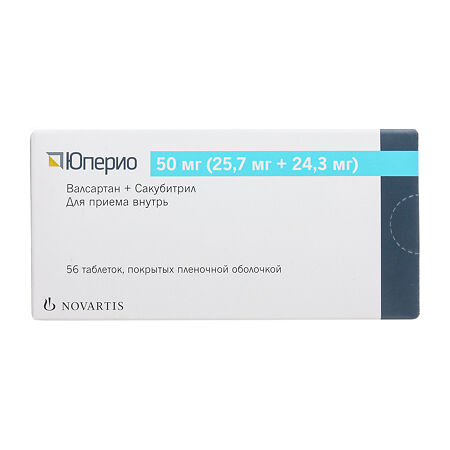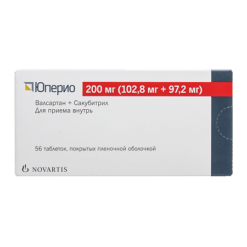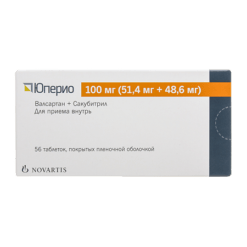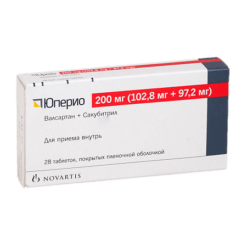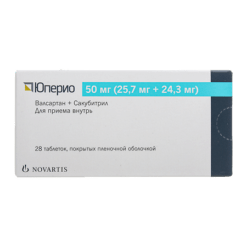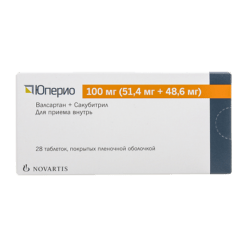No products in the cart.
Huperio, 50 mg 56 pcs.
€83.73 €72.56
Description
The action of Huperio is mediated by a novel mechanism, namely simultaneous inhibition of neprilysin (neutral endopeptidase, NEP) activity by LBQ657 (the active metabolite of sacubitril) and blockade of angiotensin II type 1 (AT1) receptors by valsartan, an angiotensin II receptor antagonist (ARA II).
The complementary beneficial effects of sacubitril and valsartan on cardiovascular and renal health in patients with heart failure are due to an increase in peptides that are cleaved by neprilysin (such as natriuretic peptides (NP)) mediated by the action of LBQ657, while simultaneously inhibiting the negative effects of angiotensin II with valsartan.
NPs activate membrane-bound receptors conjugated with guanylyl cyclase, resulting in increased cyclic guanosine monophosphate (cGMP) concentration causing symptoms of vasodilation, increased natriuresis and diuresis, increased glomerular filtration rate and renal blood flow, suppression of renin and aldosterone release, reduced sympathetic activity, and antihypertrophic and antifibrotic effects.
Valsartan, by selectively blocking the AT1 receptor, suppresses the negative effects of angiotensin II on the cardiovascular system and the kidneys and also blocks angiotensin II-dependent release of aldosterone. This prevents persistent activation of the renin-angiotensin-aldosterone system (RAAS), which causes vasoconstriction, renal sodium and water retention, activation of cell growth and proliferation, and subsequent restructuring of the cardiovascular system, exacerbating the impairments in its function.
Pharmacodynamics
The pharmacodynamic effects of sacubitril and valsartan in the drug were evaluated after its single and repeated use in healthy volunteers as well as in patients with chronic heart failure. The observed effects corresponded to the mechanism of action of the complex of active substances, consisting in simultaneous inhibition of neprilysin and RAAS blockade.
. In a seven-day study in patients with reduced left ventricular ejection fraction (LVEF), in which valsartan was used as a control, the use of sacubitril and valsartan led to a statistically significant short-term increase in natriuresis, increased urinary cGMP concentration and decreased plasma concentrations of atrial natriuretic peptide (MR-proANP) and the N-terminal fragment of brain natriuretic peptide precursor (NT-proBNP) (compared with valsartan).
In a 21-day study in patients with reduced left ventricular PV, use of sacubitril and valsartan caused statistically significant increases in urinary atrial natriuretic peptide (ANP) and cGMP and plasma cGMP concentrations, as well as decreases in plasma NT-proBNP, aldosterone and endothelin-1 concentrations (compared with baseline). In addition, use of sacubitril and valsartan blocks the AT1 receptor, as indicated by increased plasma renin activity and concentrations.
In another study, the complex of sacubitril and valsartan caused a more pronounced decrease in plasma NT-proBNP concentrations and a greater increase in urinary concentrations of brain natriuretic peptide (BNP) and cGMP than did enalapril. While BNP is a substrate of neprilysin, NT-proBNP is not, so NT-proBNP, unlike BNP, can be used as a biomarker in the monitoring of heart failure patients receiving the sacubitril and valsartan complex. In a study detailing the QTc interval in healthy male volunteers, the use of sacubitril and valsartan complex once at doses of 400 mg and 1200 mg had no effect on myocardial repolarization.
Neprilysin is one of several enzymes involved in the metabolism of amyloid-r (Ar) of the brain and cerebrospinal fluid (CSF). In healthy volunteers, the use of the sacubitril and valsartan complex at a dose of 400 mg once daily for 2 weeks increased the concentration of Ar 1-38 in the CSF; while the concentrations of Ar 1-40 and 1-42 in the CSF remained unchanged. The clinical significance of this fact is unknown. In a clinical study, use of sacubitril and valsartan complex in patients with chronic heart failure statistically significantly reduced the risk of cardiovascular death or hospitalization due to acute heart failure (21.8% in the study drug group versus 26.5% in the enalapril group).
The absolute reduction in the risk of cardiovascular mortality or acute heart failure hospitalization was 4.7%o (3.1%o for risk of cardiovascular mortality and 2.8%o for primary acute heart failure hospitalization).
The relative risk reduction compared with enalapril was 20%. The effect was noted early in the use of the drug and persisted throughout the study period. Both active ingredients of the drug contributed to the development of the effect. The incidence of sudden death, which accounted for 45% of all cardiovascular deaths, was reduced by 20% in the study drug group compared to the enalapril group (hazard ratio (hazard rAT1o, HR) 0.80, p=0.0082).
The incidence of myocardial insufficiency, which caused 26% of cardiovascular deaths, decreased 21% in the study drug group compared with the enalapril group (HR 0.79, p=0.0338).
Pharmacokinetics
Intake
After oral administration, the complex of sacubitril and valsartan breaks down into sacubitril, which is then metabolized to form the metabolite LBQ657, and valsartan; plasma concentrations of the above substances reach a maximum after 0.5 h, 2 h and 1.5 h, respectively. The absolute bioavailability of sacubitril and valsartan after oral administration is >60% and 23%, respectively. When sacubitril and valsartan are taken twice daily, equilibrium concentrations of sacubitril, LBQ657 and valsartan are reached after 3 days. No statistically significant accumulation of sacubitril and valsartan at equilibrium is noted; however, the accumulation of LBQ657 is 1.6 times the concentration with a single application.
The administration of sacubitril and valsartan complex simultaneously with meals had no clinically significant effect on the systemic exposure of sacubitril, LBQ657, and valsartan. Reduced valsartan exposure when taking the sacubitril and valsartan complex concomitantly with meals was not accompanied by a clinically significant reduction in therapeutic effect. The timing of administration of sacubitril and valsartan complex is independent of the timing of meals.
Distribution
The complex of sacubitril and valsartan is significantly bound to plasma proteins (94% to 97%). A comparison of plasma and CSF exposures shows that LBQ657 penetrates the blood-brain barrier to a small degree (0.28%). The apparent volume of distribution of the complex ranges from 75 to 103 liters.
Metabolism
Sacubitril is rapidly converted by enzymes to the metabolite LBQ657, which is not significantly metabolized further. Valsartan is metabolized to a negligible extent, only about 20%) of the administered dose is found as metabolites. A hydroxyl metabolite was detected in low concentrations (<10%) in blood plasma. Since both sacubitril and valsartan are minimally metabolized with cytochrome CYP450 isoenzymes, a change in their pharmacokinetics is unlikely with concomitant use of drugs that affect CYP450 isoenzymes.
Linearity/nonlinearity
In the studied dose range of sacubitril and valsartan complex (50-400 mg), the pharmacokinetic parameters of sacubitril, LBQ657, and valsartan vary in proportion to dose.
Pharmacokinetics in Special Clinical Cases
Patients older than 65 years
The exposures of LBQ657 and valsartan in patients in this category are 42% and 30% higher, respectively, than in younger patients. These differences are not associated with clinically significant effects, so no dose adjustments are required.
Patients younger than 18 years of age
The use of the drug in patients in this category has not been studied.
Patients with impaired renal function
A correlation between renal function and area under the concentration-time curve (AUC) was observed for LBQ657, no such correlation was observed for valsartan. In patients with mild to moderate renal dysfunction (calculated glomerular filtration rate (rGFR) >30 ml/min/1.73 m <60 ml/min/1.73 m ), the AUC of LBQ657 was 2-fold higher than in patients with normal renal function. No dose adjustment is required in patients with mild to moderate renal dysfunction. In patients with severe renal dysfunction (pSCFR 30 ml/min/1.73 m) AUC of LBQ657 was 2.7 times higher, the recommended dose for this category of patients is 50 mg twice a day. Caution should be exercised when using the drug in patients with severe renal dysfunction due to limited relevant data. There are no data on the use of the drug in patients on hemodialysis. However, both LBQ657 and valsartan are significantly bound to plasma proteins, so their effective elimination from the blood by hemodialysis is unlikely.
Patients with hepatic impairment
In patients with mild to moderate hepatic impairment, exposure to sacubitril was increased 1.5 and 3.4-fold, respectively. Exposure to LBQ657 was 1.5 and 1.9 times, and to valsartan 1.2 and 2.1 times (compared with healthy volunteers). No dose adjustment is required in patients with mild hepatic impairment (Child-Pugh class A), including those with biliary obstruction. In patients with moderate liver dysfunction (Child-Pugh class B), the recommended starting dose of the drug is 50 mg twice daily. Due to lack of data, use in patients with severe hepatic impairment is not recommended.
Ethnicity
The pharmacokinetics of Sacubitril-Valsartan Complex do not differ significantly between racial and ethnic groups.
Performance
The pharmacokinetics of sacubitril and valsartan complex (sacubitril, LBQ657, and valsartan) are not significantly different in men and women.
Indications
Indications
Active ingredient
Active ingredient
Composition
Composition
1 film-coated tablet, 50 mg (25.7 mg + 24.3 mg) contains:
The active ingredient:
Sacubitril and valsartan sodium salt hydrate complex -56.551 mg (in terms of acidic form anhydrous 50 mg, which is equivalent to the content of 24.3 mg of sacubitril and 25.7 mg of valsartan);
Excipients: microcrystalline cellulose – 91.449 mg, hyprolose – 25.000 mg, crosspovidone – 18.000 mg, magnesium stearate – 6.000 mg, talc – 2.000 mg, colloidal silicon dioxide – 1.000 mg;
coating: white shell premix – 7.957 mg (hypromellose – 5.681 mg, titanium dioxide – 1.138 mg, macrogol 4000 – 0.569 mg, talc – 0.569 mg), red shell premix – 0.019 mg (hypromellose – 0.014 mg, iron oxide red dye – 0,003 mg, macrogol 4000 – 0.001 mg, talc – 0.001 mg), film coating premix black – 0.024 mg (hypromellose – 0.017 mg, iron oxide black dye – 0.003 mg, macrogol 4000 – 0.002 mg, talc – 0.002 mg).
How to take, the dosage
How to take, the dosage
The timing of taking Juperio is independent of the time of eating.
The target (maximum daily) dose of Huperio is 200 mg (102.8 mg + 97.2 mg) 2 times daily. The recommended starting dose of Huperio is 100 mg (51.4 mg + 48.6 mg) 2 times daily.
In patients who have not previously received ACE inhibitors or ARA II therapy, or who received these drugs in low doses, therapy with Huperio should be started in a dose of 50 mg (25.7 mg + 24.3 mg) 2 times daily with a slow increase of the dose (doubling the daily dose once every 3 to 4 weeks). Depending on tolerability the dose of Intresto should be doubled every 2-4 weeks up to the target (maximum daily) dose of 200 mg (102.8 mg + 97.2 mg) 2 times per day.
The use of Juperio is possible not earlier than 36 hours after ACE inhibitor withdrawal because development of angioedema is possible in case of concomitant use. Because Imperio contains ARA II valsartan, it should not be used concomitantly with another drug containing ARA II.
If signs of impaired tolerability of Imperio develop (clinically significant decrease in BP, hyperkalemia, impaired renal function), a temporary dose reduction or dose adjustment of concomitant medications should be considered.
Patients with special categories
Patients with impaired renal function
In patients with mild (rCF 60-90 ml/min/1.73 m2) or moderate (rCF 30-60 ml/min/1.73 m2) renal dosage adjustment is not required. In patients with severe renal impairment (rSKF 30 ml/min/1.73 m2 ) the recommended starting dose is 50 mg twice daily. Caution is recommended when using Imperio in patients in this category due to limited relevant data.
Patients with hepatic impairment
In patients with mild hepatic impairment (class A according to the Child-Pugh classification), no adjustment of the dose of Imperio is required. In patients with moderate hepatic impairment (Child-Pugh class B), the recommended starting dose is 50 mg twice daily. Huperio is not recommended for use in patients with severe hepatic impairment (Child-Pugh class C).
The use in children and adolescents under 18 years of age
There are no data on the safety and effectiveness of Huperio in children and adolescents.
Uperio use in patients over 65 years of age
There is no need for dose adjustment in patients over 65 years of age.
Interaction
Interaction
Contraindicated drug interactions ACE inhibitors Imperio is contraindicated for use concomitantly with ACE inhibitors because suppression of nepralysin concomitantly with ACE inhibitor use may increase the risk of angioedema.
Uperio may be used no sooner than 36 hours after ACE inhibitor withdrawal. Use of an ACE inhibitor is possible no sooner than 36 hours after the last dose of Huperio.
Aliskiren
Uperio should not be used concomitantly with aliskiren in diabetic patients and patients with impaired renal function (rSFR <60 ml/min/1.73 m2 body surface area).
Not recommended drug interactions
Angiotensin receptor antagonists
As one of the active substances of the drug is an angiotensin II receptor antagonist, concomitant use with another drug containing ARA II is not recommended.
Drug interactions to be considered
HMG-CoA reductase inhibitors (statins)
The data from studies show that sacubitril inhibits the activity of OATP1B1 and OATP1BZ transporters. Huperio may increase systemic exposure to OATP1B1 and OATP1BZ substrates such as statins. In patients who received Juperio concomitantly with atorvastatin, the maximum plasma concentration (Cmax) of atorvastatin and its metabolites was increased up to 2 times, and AUC – up to 1.3 times. For this reason, Juperio should be used with caution concomitantly with statins.
Sildenafil
In patients with significant BP elevation receiving Huperio (before reaching equilibrium concentration), single use of sildenafil enhanced the antihypertensive effect compared to use of Huperio in monotherapy. For this reason, sildenafil or another type 5 phosphodiesterase inhibitor should be used with caution in patients receiving Huperio.
Presumed drug interactions to be considered
Potassium
Concomitant use of potassium-saving diuretics (e.g., triamterene and amiloride), mineralocorticoid antagonists (e.g., spironolactone and eplerenone), potassium products or potassium-containing table salt substitutes may cause increased potassium and serum creatinine concentrations. In patients receiving Juperio concomitantly with these drugs, it is recommended to monitor serum potassium levels regularly.
Non-steroidal anti-inflammatory drugs (NSAIDs), including selective cyclooxygenase-2 inhibitors (COX-2 inhibitors). The use of Huperio concomitantly with NSAIDs in patients over 65 years of age, in patients with hypovolemia (including patients receiving diuretics) and in patients with impaired renal function may increase the risk of impaired renal function. In patients receiving Juperio concomitantly with NSAIDs, it is recommended to monitor renal function when prescribing a similar treatment regimen and in case of its change.
Lithium preparations
The possibility of drug interaction between Huperio and lithium preparations has not been studied. Concomitant use of lithium with ACE inhibitors and ARA II has resulted in a reversible increase in serum lithium concentration and, therefore, in an increase in toxic effects. In patients receiving Juperio together with lithium preparations, it is recommended to carefully monitor the lithium content in blood serum. The risk of lithium toxicity may increase if additional diuretic medication is used.
The transporter proteins
The active metabolite of sacubitril (LBQ657) and valsartan are substrates of the transporter proteins 0ATP1B1, 0ATP1BZ and OATZ; valsartan is also a substrate of the transporter protein MRP2. Patients receiving Huperio concomitantly with OATP1B1, OATP1BZ, OATZ inhibitors (e.g., rifampicin and cyclosporine) or MRP2 (e.g., ritonavir) may have increased systemic exposure to LBQ657 or valsartan, respectively. Caution is required at the start and end of coadministration of Huperio and this group of drugs.
There are no significant drug interactions. No clinically significant interactions have been identified when Huperio is used in combination with furosemide, digoxin, warfarin, hydrochlorothiazide, amlodipine, metformin, omeprazole, carvedilol, IV nitroglycerin (IV) or a combination of levonorgestrel and ethinylestradiol.
Interactions with atenolol, indomethacin, glibenclamide (gliburide) or cimetidine are not expected when combined with Huperio.
Interactions with cytochrome P450 isoenzymes
The available studies demonstrate that the likelihood of drug interactions mediated by CYP450 cytochrome isoenzymes is low, because the active substance complex is only slightly metabolized with the participation of CYP450 isoenzymes. The active substance complex of Huperio is not an inhibitor or inducer of CYP450 isoenzymes.
Special Instructions
Special Instructions
Significant decrease in BP
In patients treated with Huperio, there have been cases of clinically significant arterial hypotension. If a marked decrease in BP occurs, consideration should be given to adjusting the dose of diuretics, concomitant hypotensive agents, and the cause of the marked decrease in BP (e.g., hypovolemia). If, despite these measures, the pronounced BP decrease persists, the dose of Huperio should be reduced or the drug should be temporarily withdrawn. Definitive withdrawal of the drug is usually not required. The likelihood of significant BP decrease is generally higher in patients with hypovolemia, which may be caused by diuretic therapy, low-salt diet, diarrhea, or vomiting.
Before starting Hyperio, sodium should be corrected and/or the BOD should be replenished.
Kidney function impairment
Like any other drug acting on the RAAS, Huperio may cause impairment of renal function. In a comparative safety and efficacy study of 14/17 (compared with enalapril), clinically significant impairment of renal function was rare, and Huperio was withdrawn less frequently (0.65%) than enalapril (1.28%) for such impairment. In cases of clinically significant impairment of renal function, a reduction in the dose of Huperio should be considered. Caution should be exercised when using Huperio in patients with severe renal dysfunction.
Hyperkalemia
Like any other drug acting on the RAAS, Huperio may increase the risk of hyperkalemia. In a comparative safety and efficacy study (compared with enalapril), clinically significant hyperkalemia was rare; hyperkalemia was withdrawn due to hyperkalemia in 0.26% of patients and enalapril in 0.35% of patients. Drugs that may increase serum potassium levels (e.g., potassium-saving diuretics, potassium preparations) should be used with caution concomitantly with Huperio. In case of clinically significant hyperkalemia, measures such as reducing potassium intake with food or adjusting the dose of concomitant drugs should be considered. Regular monitoring of serum potassium is recommended, especially in patients with risk factors such as severe renal dysfunction, diabetes mellitus, hypoaldosteronism, or a diet high in potassium.
Anhyoneurotic edema
In cases of angioedema have been reported with the use of Huperio. If angioedema occurs, Imperio should be stopped immediately and the patient should be appropriately treated and monitored until all symptoms have resolved completely and permanently. Reapplication of Huperio should not be repeated. In cases of confirmed angioedema, where the swelling was limited to the face and lips, the condition usually resolved without intervention, although use of antihistamines did ameliorate the symptoms.
Synopsis
Synopsis
Contraindications
Contraindications
Side effects
Side effects
The observed adverse events (AEs) were consistent with the pharmacological characteristics of Huperio and the comorbidities of the patients. The most frequent NIs were marked decrease in blood pressure, hyperkalemia, and renal dysfunction caused by adjusting the dose of Huperio or discontinuing therapy. The frequency of NNDs was independent of patient gender, age, or race. The NNIs are listed according to the system-organ class of the MedDRA Regulatory Dictionary. Within each system-organ class, NUIs are categorized by frequency of occurrence in decreasing order of importance.
The following criteria were used to assess frequency: very frequent (>1/10); frequent (>1/100 to <1/10); infrequent (>1/1,000 to <1/100); rare (>1/10000 to <1/1000); very rare (<1/10000), including individual reports.
Metabolic and nutritional disorders: very common – hyperkalemia; common – hypokalemia.
Nervous system disorders: frequent – dizziness, headache; infrequent – orthostatic dizziness.
Hearing organ and labyrinth disorders: often – vertigo.
Vascular disorders: very common – marked decrease in BP: common – syncope, orthostatic hypotension.
Respiratory system, chest and mediastinum disorders: often – cough.
Gastrointestinal disorders: frequently – diarrhea, nausea.
Gastrointestinal disorders: infrequent – angioedema.
Renal and urinary tract disorders: very common – renal dysfunction; common – renal failure (including acute renal failure).
General disorders and disorders in the place of administration: often – increased fatigue, asthenia.
If any of the side effects listed in the instructions worsen, or if you notice any other side effects not listed in the instructions, tell your doctor.
Overdose
Overdose
There are insufficient data on overdose with Huperio in humans. A single dose of 1200 mg and multiple doses of 900 mg in healthy volunteers were well tolerated.
The most likely symptom of overdose is a marked decrease in BP due to the antihypertensive effect of the active substances. Symptomatic treatment is recommended in this case.
In case of accidental overdose, vomiting should be induced (if the drug was taken recently) or gastric lavage should be performed. In case of pronounced BP lowering as a therapy intravenous injection of 0.9% sodium chloride solution is necessary, the patient should be laid with his legs elevated for the period required for therapy, active measures on cardiovascular system support, including regular monitoring of heart and respiratory system activity, circulating blood volume (CBC) and amount of urine excreted should be taken. Removal of active ingredients during hemodialysis is unlikely, as much of them are bound to plasma proteins.
Pregnancy use
Pregnancy use
Patients with preserved reproductive potential should be informed of the possible effects of using the drug during pregnancy, and of the need to use reliable contraception during treatment with the drug and for one week after the last dose.
As with other drugs directly acting on the RAAS, Huperio should not be used during pregnancy. The action of Huperio is mediated by angiotensin II receptor blockade, therefore the risk to fetus cannot be excluded. pregnant women taking valsartan have had cases of spontaneous miscarriage, presumptive failure and impaired renal function in neonates.
If the patient becomes pregnant during treatment with the drug, she should stop taking it and inform her physician. Since in preclinical studies there has been excretion of sacubitril and valsartan with the milk of lactating animals, it is not recommended to use Juperio during breastfeeding. The decision to stop breastfeeding or to discontinue Huperio and to continue breastfeeding should be made taking into account the importance of its use for the mother. There are no data on the effect of Hyperio on fertility in men and women. No reduction in fertility has been observed in studies of Huperio in animals.
Additional information
| Shelf life | 30 months. The drug should not be used after the expiration date. |
|---|---|
| Conditions of storage | At a temperature not exceeding 25 ° C. Keep out of reach of children. |
| Manufacturer | Novartis Neva LLC, Russia |
| Medication form | pills |
| Brand | Novartis Neva LLC |
Other forms…
Related products
Buy Huperio, 50 mg 56 pcs. with delivery to USA, UK, Europe and over 120 other countries.

